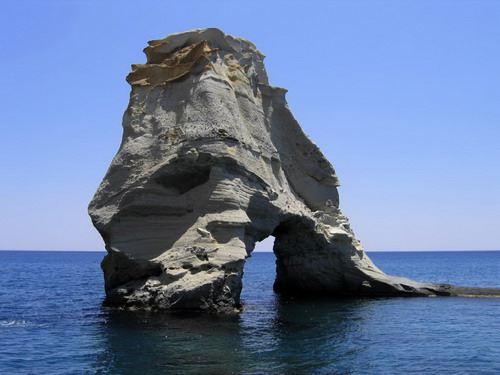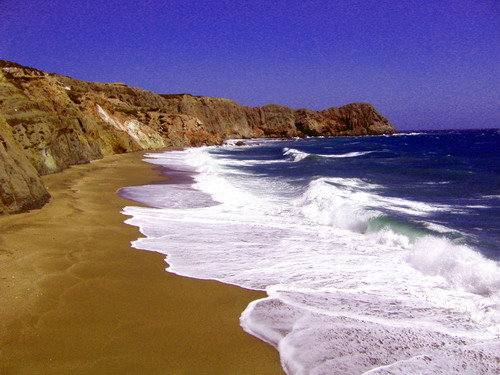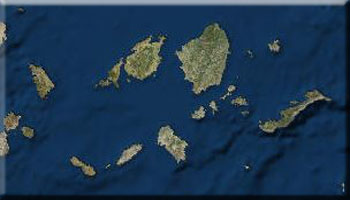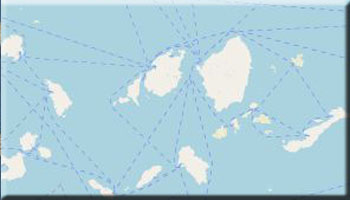 KLIMA
KLIMA
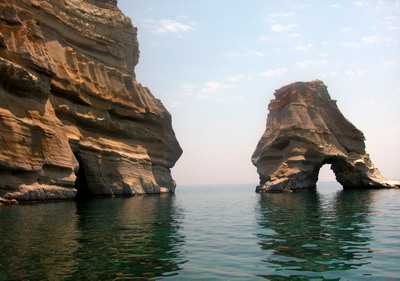 KLEFTIKO
KLEFTIKO
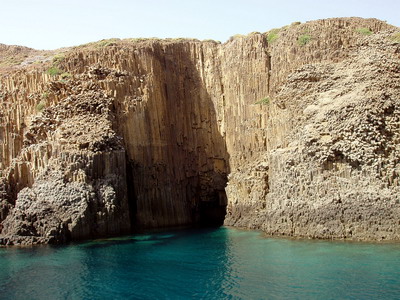 GLARONISIA
GLARONISIA
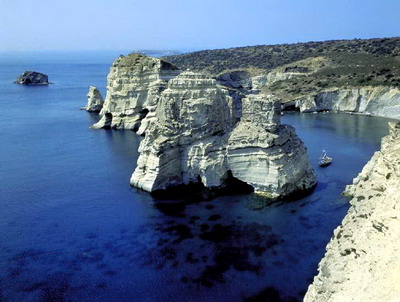 KLEFTIKO
KLEFTIKO
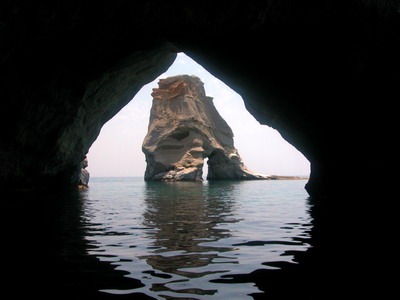 SIKIA
SIKIA
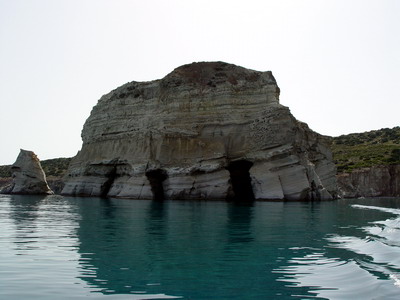 KLEFTIKO
KLEFTIKO
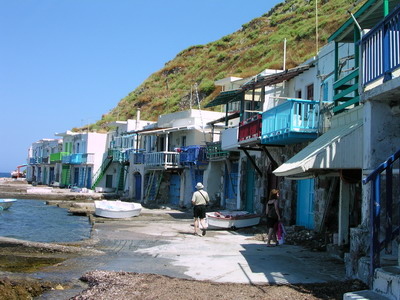 KLIMA
KLIMA
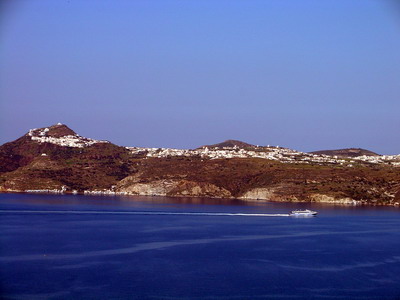 VILLAGES
VILLAGES
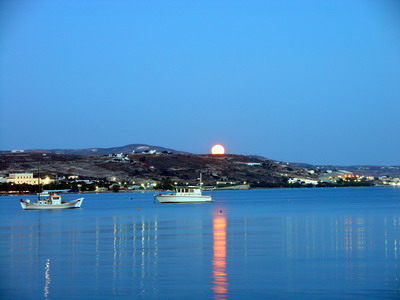 ADAMANTAS
ADAMANTAS
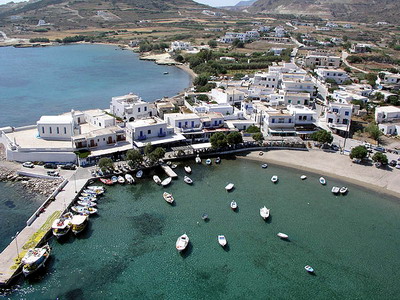 APOLLONIA
APOLLONIA
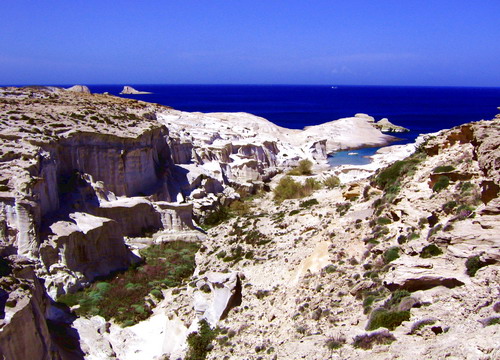 SARAKINIKO
SARAKINIKO
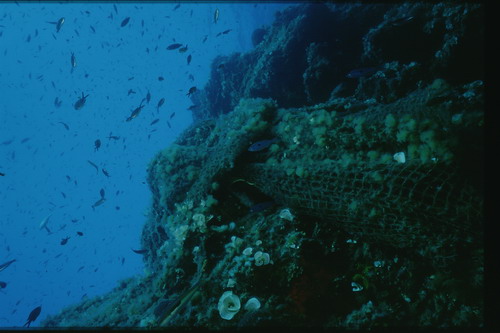 DIVE
DIVE
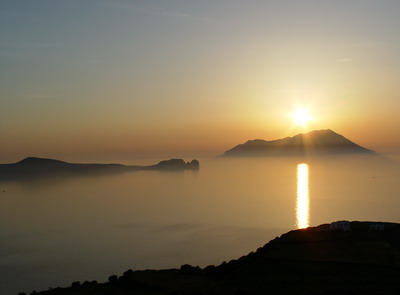 SUNSET
SUNSET
Milos is located in the northwestern Cyclades, 86 nautical miles from Piraeus and roughly midway between Piraeus and Crete. The island has an area of 151 square kilometers and is the fifth largest island in the group, with a 125-kilometer coastline. Its location is 36ο 44' 35'' N and 24ο 25' 28'' east (Plaka). Though considered a low island, its highest peak - Profitis Ilias - rises to 751 meters; a second peak, Hondro Vouno reaches 636 meters, but the rest of its hills and mountains do not top 400 meters.
Adamantas, a broad natural harbor and one of the largest in the Mediterranean, has played a major role in the island's history and economy, in concert with Milos's mineral wealth. There are daily ferry links between Piraeus and Milos; non-stop, the journey by conventional ferry takes about 5 hours, reaching over 7 when the route includes stops at other islands (Kithnos, Serifos, Sifnos, and Kimolos). In the summer there are three to four weekly sailings from Milos to Ios, Sikinos, Folegandros, Santorini, Crete, and the eastern Cyclades.
Milos has an airport, with daily flights to Athens. Routes are more frequent in the summer months (May through October) than during the winter. Flight time is 30 minutes; the airport is 4.5 kilometers from the port, Adamantas.
The island has a good road network, whose trunk is extended by good dirt roads and tracks. Buses reach all main destinations, with frequent routes from Adamantas to most settlements and beaches. There is a taxi station at Adamantas.
Milos has a population of 5,000, which swells in the summer months. Most settlements are concentrated in the north around eight main villages: the capital Plaka, Plakes, Triovasalos, Pera Triovasalos, Trypiti, Pollonia, Zefyria, and Adamantas.
Milos is the seat of one of four eparchies of the Cyclades Prefecture; the eparchy includes Kimolos, Sifnos, and Serifos. Geologically, Milos is volcanic - as is Kimolos. It is barren, with sparse vegetation and no forests, streams, or cascades. Thanks to its unique geology, the island boasts 75 gorgeous beaches with pristine waters - some sand, some white, red, yellow or black shingle.
Milos flourished in antiquity thanks to its mineral-rich soil. Inhabited since Neolithic times (7000 B.C.), it grew wealthy by trading obsidian, a black volcanic rock used for making weapons and tools—traces of which have been found in the Peloponnese, on Crete and Cyprus, and as far away as Egypt.
In the Early Bronze Age (2800-1100 B.C.), the island had a prominent role in the Cyclades, as evidenced by the emergence of an entire civilization centered on the ancient city of Phylakope. The arrival of the Dorians in Hellenistic times, around 1000 B.C., is marked by the founding of a new city at the site of present-day Klima.
Milos fought with the other Greeks against the Persians at the battles of Salamis and Plataea, but the city was destroyed by Athens in 415 B.C. in retaliation for its neutrality in the Peloponnesian War.
Milos came under the rule of Macedonia until 311 B.C., then passed into the hands of the Egyptians. The Ptolemies’ supremacy at sea helped Milos rebuild its economy and under the island’s renewed prosperity, the arts flourished. The famed statue of Aphrodite of Milos, also known as the Venus de Milo, currently at the Louvre Museum in Paris dates from this period, as does the 2.5-meter statue of Poseidon in the collection of the National Archaeological Museum in Athens.
Under Roman rule, Milos acquired a marble theater. In the first century, the island converted to Christianity, as evidenced by the Catacombs — the largest complex of underground burials in Greece and one of the most important in the world.
Archaeological Museum: As we enter the main exhibition hall of the Archaeological Museum, the striking statue of the Venus de Milo meets our gaze. Unfortunately it is only a copy - although a very fine one - produced by the Louvre Museum workshop. Among the more important exhibits in the same room, is a 6th century B.C. funeral urn with a chariot race represented in relief pattern, a robed 3rd century B.C. statue, a lion decoration used as a table support and a female bust. A display case in the hall’s left section contains Neolithic relics, mostly obsidian tools, knives, arrows, and spearheads from Phylakope, Nyhia, and Demenagakis.
Other exhibits offer evidence of the artistic achievements of ancient Klima, including a masterful head with a burnished face and a section of a 3rd-century-B.C. tombstone depicting, in bas relief, a youth and his servant. Other finds from excavations around the island include stones inscribed with the 21-letter ancient alphabet of Milos. There are numerous finds from Phylakope, among them vessels with drawings of lilies and idols from Phylokope IV. Directly behind the Aphrodite statue, a display showcases coins, blades, and bronze figurines from the 5th and 4th centuries B.C., Roman-era glass and clay vessels, and reliefs and idols from the Hellenistic period.
Ecclesiastical Museum: Housed in the Church of Ayia Triada (Holy Trinity), just a short distance from the port, the Ecclesiastic Museum features 14th-century icons and fine samples of hagiography. The triple-apsed church, built after the Iconomachy (A.D. 824), is a museum piece itself.
Folklore Museum: Founded in 1967 by the Milos Society of Athens, under the guiding influence of Zafiris Vaos, the Folklore Museum features exhibits highlighting local folk culture. Exhibits include wax dolls dressed in traditional costumes, rare embroideries, and a recreation of a traditional household, including loom, kitchen, sleeping quarters, and pantry.
Milos Mining Museum: Opened in 1998, the Mining Museum is spread over three floors. Entering the ground floor, visitors come across a model depicting the volcanic eruption that shaped the island and a large geological map of Milos. Illuminated panels highlight mining activities to date, with images of tools and mining equipment used since mining began.
First floor exhibits include rocks and minerals from the island and around Greece, most importantly important minerals found on the island today. There are also fossils, and samples of obsidian, bauxite, alumina, and aluminum, photographic documents from the now defunct manganese and sulphur mines and the millstone quarries.
Among noteworthy exhibits are a Roman-era grindstone and a cedar trunk uncovered 28 meters below the surface at the bentonite quarry at Aggeria that is believed to be 2,000 years old. The library in the basement is also used for hosting talks and other events.
Maritime Museum of Milos: Created thanks to the efforts of dr. Petros Armenis, who managed to gather and exhibit, with the help of locals, with much love and respect, a wide range of articles. The museum operates since the September of 2008.
The museum's exhibits are quite much and rare as well and extend from the prehistoric times, reaching the early ages of the island's history.
The visitor will also have the chance to witness rare maritime maps, created by special craftsmen of the times, while the famous wooden boat "Irene" holds an outstanding position among the exhibits. The museum is located at Adamantas.
Catacombs : The Milos Catacombs are dug into a sheer slope near the village of Trypiti where the island’s early Christians gathered for worship and to bury their dead. The catacombs are unique in Greece and considered among the most important, along with those of Rome and the Holy Land.
Originally discovered by tomb robbers and relic hunters, the catacombs came to light in 1840, after they were looted. They comprise three chambers linked by five corridors and a funerary chamber, all arranged in a labyrinthine network that extends a total of 185 meters. The catacombs were once accessible along their length and breadth, but today just one chamber, the chamber of Elders, is accessible to the public. Though just 126 vaulted recesses with graves survive, it’s estimated that thousands of Christians were buried in the catacombs.
The graves of prominent citizens are marked with Christian symbols and inscriptions, such as the “Presvytera” (elder or vicar) inscription after which the chamber was named. Worth noting is a sarcophagus carved into the rock that is believed to be the burial of one of the early Christian martyrs. The tomb was subsequently used as an altar. The catacombs were used for worship and burials before Christian worship was allowed by the Decree of Medolianos and were abandoned around the fifth or sixth century when the ancient city of Klima was razed by an earthquake.
Sulphur Mines: Remains of the old sulphur mines are visible on the island’s eastern coast at the Paliorema cove. The mines were active until 1956 and are considered a prime sight in the island’s geological history.
Milos Conference Center - Giorgos Iliopoulos: Located on a four-acre estate at Adamantas. The center is open year - round and has a capacity of 320 delegates. It’s one of the largest such facilities in Greece and offers separate press room, internet room, infirmary, and 100 parking spaces. The conference center is fully air conditioned, has access for the physically disabled and an independent fire-protection system.
Milos boasts over 70 gorgeous beaches that captivate visitors thanks to their pale gold sand, shimmering turquoise waters, and multicolored reflections on a seabed laid with volcanic rock.
Sparkling, pristine waters and fine sand are the hallmark of Milos's coastline, making the island an ideal destination for beach-lovers who can choose to visit a different beach each day, with varied landscapes and shelter according to the wind's direction. In August, a period marked by strong northerly winds, the beaches along the island's southern shore are sheltered, while the western coast is sheltered from southerly gusts.
Milos's extensive road network offers access to most beaches, starting from the expansive harbor at Adamantas with the beaches at Papikinos and Ahivadolimni. Beaches on the northern coast are linked by road, which also extends to beaches on the southern coast as far as Ahivadolimni and Provatas. Access to more distant beaches is by good dirt road. Ayios Ioannis and Triades on the western coast can be reached by dirt roads, although access, especially in the early summer, is difficult by vehicles without four-wheel drive.
Milos's northern coast is formed by a sheer, rocky coast and the barren terrain resembles a lunar landscape. These beaches are not recommended for swimming when strong northerly winds are blowing. The main beaches on the northern shore are Sarakiniko, a small, somewhat remote cove; Mytakas, Alogomantra, Papafrangas, and Ayios Konstantinos are dotted with caves, rock formations that offer natural bridges, and snug patches of sand. These beaches are not organized, but the beauty of the landscape more than compensates the visitor for the lack of facilities.
Beaches on the eastern coast are accessible via Pollonia. Few offer facilities and most are pebble or shingle. In addition to those beaches accessible by road, there are a number of remote sand coves accessible by boat from Pollonia.
The western coast is the least accessible, but it's worth braving the rough tracks to enjoy the totally unspoilt landscape. Bathers should bring drinking waters because there are no shops or other facilities beyond Ahivadolimni. Beaches on the western shore includes the twin beaches at Ayios Ioannis, accessible only by boat; Triades, with its three sand coves; and the striking sea caves at Ammoudaraki.
Milos's southern coast is accessible by road and sheltered from the August meltemi gusts and northerly winds. These sand beaches offer a range of facilities. The most picturesque is Yerontas, with its dark-colored sand, pristine waters, and dreamy landscape. Ayia Kyriaki, a pretty beach with coarse sand and white pebbles about eight kilometers from Adamantas, offers a restaurant, beach bar, and water sports facilities. Other beaches include Paliohori and Provatas, a seaside village seven kilometers from Adamantas with golden sands, rocks, and shallow waters offers restaurants, cafes, fish tavernas, and accommodations. The beaches at Fyriplaka and Tsigrado may not offer tavernas but bathers will enjoy the grey-hued sands and unique landscape. Fyriplaka offers some facilities, and beach umbrellas and sun beds are also available at Portokali.
Milos’s rich tradition is preserved in a number of folk feasts or paniyiria featuring local food, wine, and music. The main folk festivals are held at the following churches in observance of their feast days:
- 50 days after Easter at Ayia Triada in Adamantas
- June 30 at Ayii Anaryiri
- July 6 at Ayia Kyriaki
- July 16 at Ayia Marina at Halakas
- July 19 at Profitis Ilias at Halakas and Komia
- July 21 at Ayia Markella at Kipos
- July 25 at Ayia Paraskevi at Pollonia
- July 26 at Ayios Pandeleimon at Plakota and Korfos
- July 31 at Prodromos tou Timiou Stavrou at Golgotha in Plakes
- August 5 at Metamorphosi in Parasporo
- August 14 at Kimisi tis Theotokou at Zefiria
- August 15 Kimisi tis Theotokou or Ayios Haralambos at Adamantas
- August 17 at Ayios Floros at Komia
- August 22 at Panayia Yiatrissa at Komia
- August 22 at Panayia at Kipos
- August 22 at Panayia Faneromeni at Trypiti
- August 26 at Ayios Fanourios at Pollonia
- August 28 at Ayios Ioannis Prodromos at Agrilies and Provatas
- August 29 at Ayios Alexandros at Katsouli
- August 31 at Pantokratora at Mytakas
- September 6 at Ayios Sostis at Provatas
- September 7 at Panayia Eleoussa at Psathadika
- September 8 at Panayia Korfiatissa at Plaka
- September 13 at Stavros at Kaneria
- September 16 at Ayios Ioannis at Halakas
The "Milos Festival" is held on the first weekend of July. It’s a three-day program of cultural events organized by the Municipality and sponsored by the S&B INDUSTRIAL MINES.
| MUNICIPALITY OF MILOS | 2287360100 |
| CITIZENS SERVICE BUREAU (KEP) | 2287022894 |
| HEALTH CENTRE | 2278360000 |
| HARBOR POLICE | 2287023360 |
| POLICE STATION | 2287021204 |
| AIRPORT | 2287022381 |
| TAXI STATION | 2287022219 |
| INFORMATION CENTRE | 2287022445 |
| POST OFFICE | 2287021214 |









